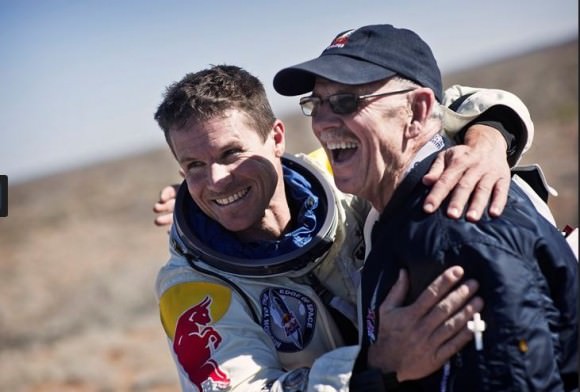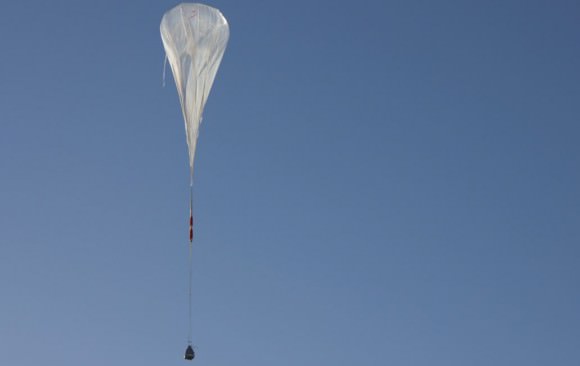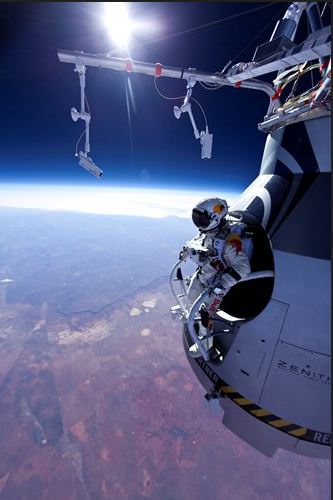[/caption]
Austrian skydiver Felix Baumgartner took a practice jump today, (March 15, 2012) to help him prepare for his leap from the edge of space later this year where he hopes to not only break the sound barrier with his body, but also break the record for the longest freefall. In preparation for his Red Bull Stratos mission, Baumgartner rode his specially-made pressurized capsule via a helium balloon and jumped from an altitude of 21,818 meters (71,581 feet, 21 kilometers, 13.5 miles) from the skies near Roswell, New Mexico.
“Felix can consider himself part of a very exclusive club today,” said a spokesperson from the Red Bull Stratos mission, “joining Joe Kittinger and Eugene Andreev (USSR) all who have jumped from above 70,000 feet.”
42-year-old Baumgartner is hoping to jump from 36,500 meters (120,000 feet) this summer, to break the current jump record held by Kittinger a retired Air Force officer, who jumped from 31,500 m (31.5 km, 19.5 miles) in 1960.
Today, Baumgartner’s freefall lasted 3 minutes 43 seconds, reaching a top speed of 586 kph (364 mph). Baumgartner deployed his parachute at 2,405 m (7,890 feet), by far the highest jump he has ever made, said Red Bull officials. And he was taken back by the difference: “I thought that I had to pull the parachute, then I looked at the altitude and realized that I’m still at 50,000 feet,” Baumgartner said in a press release.

Officials said he was “super jazzed” about the jump today, saying “I can’t wait to stand on that step. I can’t wait!”
Today’s test was the first “manned” capsule flight lifted by a high-altitude balloon. Baumgartner flew above a life-critical zone known as the Armstrong Line, all the way to an estimated 21,818 meters. Above 18,900 meters (62,000 feet) is not survivable without a pressure suit, and at that height, Baumgartner also experienced the coldest part of the atmosphere with temperatures as low as -70 C (-94F).
Baumgartner said later the most difficult part was the extreme cold he encountered. “I could hardly move my hands,” he said. “We’re going to have to do some work on that aspect.”
Reportedly Kittinger, now 83 and who is on the team assisting in the mission, sent Baumbartner a message before he jumped: “Felix, you’re going to have one heck of a view when you step out of that door… enjoy the experience.”
Baumgartner landed safely in an open field just to the east of Roswell, New Mexico. “This test serves as the perfect motivation for the team for the next step,” said Baumgartner after he touched down, referring to his upcoming record-breaking jump attempt.

For more info see the Red Bull Stratos website.


I find it intresting how 13.5 miles can seem so different depending on context. The first picture in this article is from 13.5 miles of vertical distance and seems like such a long way, and yet I drive about the same distance to work every day and never give it a second thought. I just can’t see it, the distance in that picture is about the same as I drive, one way, on a daily basis!
I totally agree with you and as aresult I had to check where the atmosphere ended in rekation to this.
From wikipedia (so obviously not the last word):
An altitude of 120 km (75 mi) is where atmospheric effects become noticeable during atmospheric reentry of spacecraft. The Kármán line, at 100 km (62 mi), also is often regarded as the boundary between atmosphere and outer space
I’m thinking, (slightly hazily I admit), I think nothing of an hour’s drive down a motorway to visit friends, yet that is the equivalent to a trip to outer-space, ( if you discount the physics). You put it far better.
How’d he recover his balloon & capsule???
Ya, I second that question!
The capsule has it’s own parachute. I believe a previous article mentioned it was put on a timer after he jumps so it can release the balloon and return to earth in one piece.
I’ve been absolutely captivated by this story for a few years now… following the few and far-between crumbs of forward steps with drooling awe-filled excitement. I have goose-bumps down my spine as I type this. I can’t WAIT for the final step… and BOY, what a doozey it will be!! 😉
Sorry. I think he is totally nuts!
Orbital skydiving is completely off the wall. It has been popularised into an extreme sport by several of the Star Trek movies and in the various TV series. See Orbital Skydiving.
I can’t imagine what it could feel like. Seeing shuttle booster video yesterday, I wonder if the force of wind could be so strong that your body could start tumbling uncontrollably, or even your arm could be ripped off..
he had problems with cold but if he manages to surpass sound speed (which i don`t believe) he might have problems with heating.
Awesome. I hope the “official” jump goes well.
Did he have a video camera on him to capture the descent?
A minor comment: the nice thing with the metric system is that 31,500 meters are, by definition, 31.5 km, and 21,818 meters are 21.818 km… I’m not sure these numbers require any special “conversion” …